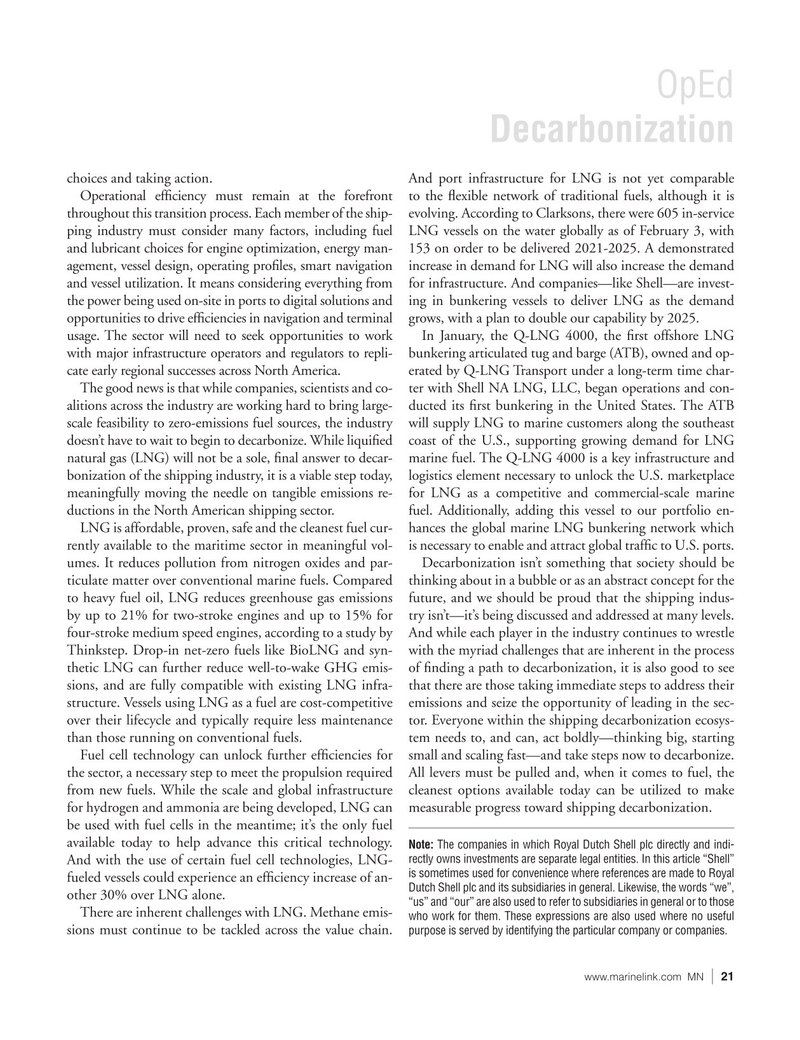
Page 21: of Marine News Magazine (March 2021)
Pushboats, Tugs & Barges
Read this page in Pdf, Flash or Html5 edition of March 2021 Marine News Magazine
OpEd
Decarbonization choices and taking action. And port infrastructure for LNG is not yet comparable
Operational ef? ciency must remain at the forefront to the ? exible network of traditional fuels, although it is throughout this transition process. Each member of the ship- evolving. According to Clarksons, there were 605 in-service ping industry must consider many factors, including fuel LNG vessels on the water globally as of February 3, with and lubricant choices for engine optimization, energy man- 153 on order to be delivered 2021-2025. A demonstrated agement, vessel design, operating pro? les, smart navigation increase in demand for LNG will also increase the demand and vessel utilization. It means considering everything from for infrastructure. And companies—like Shell—are invest- the power being used on-site in ports to digital solutions and ing in bunkering vessels to deliver LNG as the demand opportunities to drive ef? ciencies in navigation and terminal grows, with a plan to double our capability by 2025. usage. The sector will need to seek opportunities to work In January, the Q-LNG 4000, the ? rst offshore LNG with major infrastructure operators and regulators to repli- bunkering articulated tug and barge (ATB), owned and op- cate early regional successes across North America. erated by Q-LNG Transport under a long-term time char-
The good news is that while companies, scientists and co- ter with Shell NA LNG, LLC, began operations and con- alitions across the industry are working hard to bring large- ducted its ? rst bunkering in the United States. The ATB scale feasibility to zero-emissions fuel sources, the industry will supply LNG to marine customers along the southeast doesn’t have to wait to begin to decarbonize. While liqui? ed coast of the U.S., supporting growing demand for LNG natural gas (LNG) will not be a sole, ? nal answer to decar- marine fuel. The Q-LNG 4000 is a key infrastructure and bonization of the shipping industry, it is a viable step today, logistics element necessary to unlock the U.S. marketplace meaningfully moving the needle on tangible emissions re- for LNG as a competitive and commercial-scale marine ductions in the North American shipping sector. fuel. Additionally, adding this vessel to our portfolio en-
LNG is affordable, proven, safe and the cleanest fuel cur- hances the global marine LNG bunkering network which rently available to the maritime sector in meaningful vol- is necessary to enable and attract global traf? c to U.S. ports.
umes. It reduces pollution from nitrogen oxides and par- Decarbonization isn’t something that society should be ticulate matter over conventional marine fuels. Compared thinking about in a bubble or as an abstract concept for the to heavy fuel oil, LNG reduces greenhouse gas emissions future, and we should be proud that the shipping indus- by up to 21% for two-stroke engines and up to 15% for try isn’t—it’s being discussed and addressed at many levels. four-stroke medium speed engines, according to a study by And while each player in the industry continues to wrestle
Thinkstep. Drop-in net-zero fuels like BioLNG and syn- with the myriad challenges that are inherent in the process thetic LNG can further reduce well-to-wake GHG emis- of ? nding a path to decarbonization, it is also good to see sions, and are fully compatible with existing LNG infra- that there are those taking immediate steps to address their structure. Vessels using LNG as a fuel are cost-competitive emissions and seize the opportunity of leading in the sec- over their lifecycle and typically require less maintenance tor. Everyone within the shipping decarbonization ecosys- than those running on conventional fuels. tem needs to, and can, act boldly—thinking big, starting
Fuel cell technology can unlock further ef? ciencies for small and scaling fast—and take steps now to decarbonize. the sector, a necessary step to meet the propulsion required All levers must be pulled and, when it comes to fuel, the from new fuels. While the scale and global infrastructure cleanest options available today can be utilized to make for hydrogen and ammonia are being developed, LNG can measurable progress toward shipping decarbonization.
be used with fuel cells in the meantime; it’s the only fuel available today to help advance this critical technology.
Note: The companies in which Royal Dutch Shell plc directly and indi- rectly owns investments are separate legal entities. In this article “Shell”
And with the use of certain fuel cell technologies, LNG- is sometimes used for convenience where references are made to Royal fueled vessels could experience an ef? ciency increase of an-
Dutch Shell plc and its subsidiaries in general. Likewise, the words “we”, other 30% over LNG alone. “us” and “our” are also used to refer to subsidiaries in general or to those
There are inherent challenges with LNG. Methane emis- who work for them. These expressions are also used where no useful sions must continue to be tackled across the value chain. purpose is served by identifying the particular company or companies.
www.marinelink.com MN 21|

 20
20

 22
22
